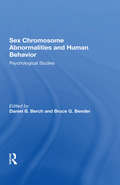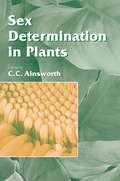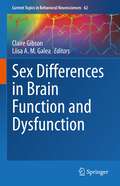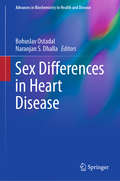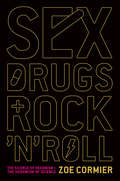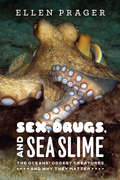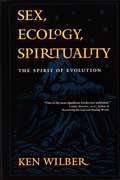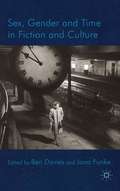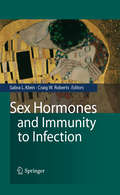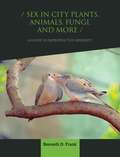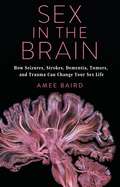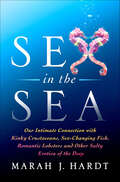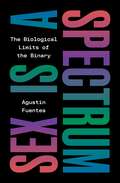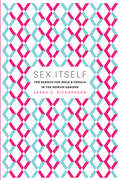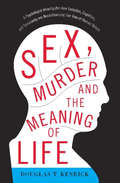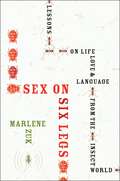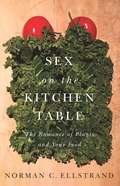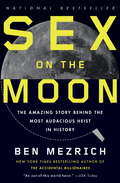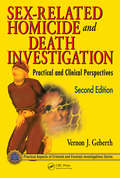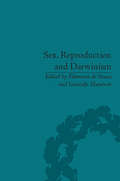- Table View
- List View
Sex Chromosome Abnormalities And Human Behavior: Psychological Studies
by Daniel B Berch Bruce G BenderThis volume is based on a symposium, "Cognitive and Psychosocial Dysfunctions Associated with Sex Chromosome Abnormalities," presented at the 1986 Annual Meeting of the American Association for the Advancement of Science. It contains reports from individual research groups and a psychological study.
Sex Chromosomes and Sex Determination in Vertebrates
by Alberto J. SolariThe cloning of the SRY gene and the attainment of XX mice transgenic for the Sry gene opened a new era in research on sex determination. This book surveys current knowledge of sex chromosomes and sex determination in all vertebrate classes, relying on the restriction of genetic recombination in sex chromosomes as the unifying concept of this subject. The book's interdisciplinary approach integrates contributions from the fields of cytogenetics, molecular biology, developmental biology, and evolutionary genetics. A detailed treatment of the meiotic behavior of sex chromosomes is featured, and the entire text is supplemented by numerous schemes, drawings, and electron micrographs.The book will be valuable to general cytogeneticists, vertebrate zoologists, and veterinarian and medical practitioners interested in the foundations of sex determination and the current knowledge of sex chromosomes. It will also interest students in advanced undergraduate and graduate courses in these areas.
Sex Determination in Plants (Society for Experimental Biology)
by C. C. AinsworthIndispensable for all plant biologists, this is a fascinating and thorough examination of those factors which affect the sex determination of plant species, describing all of the main classes of plant with unisexual flowers hermaphrodite, monoecious and
Sex Differences in Brain Function and Dysfunction (Current Topics in Behavioral Neurosciences #62)
by Claire Gibson Liisa A. M. GaleaDoes sex matter when it comes to brain function? This volume attempts to answer this very important question which is of relevance to the disciplines of psychology, neuroscience, psychiatry and neurology. Understanding how brain function and resultant behaviors may differ between the sexes impacts upon our knowledge of the pathology and development of treatments for various neurological and psychiatric disorders, particularly those that show significant sex differences in either prevalence and/or manifestation of symptoms. This volume covers three main themes of research into sex differences in basic neurobiology, psychology, preclinical research and clinical research. It begins by exploring our understanding of sex and gender in relation to both animal and human behaviors and discusses the relevance, and importance, of considering sex and gender when conducting research into brain function and behaviors. The second theme focuses on how sex and gender influence mental health and considers the impact of our immune system and the changes that occur with ageing. Finally, the third aspect focuses on examples of neurological disorder which show sex differences in terms of their aetiology and/or symptomology and considers the relevance in the development of treatment for these disorders including dementia, stroke and multiple sclerosis. This volume is of considerable interest to mental health and neurology professionals, including psychiatrists, neurologists, nurses, allied health clinicians and pharmacists. It is also helpful and important for preclinical researchers working in neuroscience, psychopharmacology and reproductive endocrinology.
Sex Differences in Heart Disease (Advances in Biochemistry in Health and Disease #21)
by Bohuslav Ostadal Naranjan S. DhallaCardiovascular diseases are the leading cause of mortality in men and women. Unfortunately, women have traditionally been excluded from clinical trials, and female animals have been used less or sex was not reported in basic research studies. Until recently, consideration of both sexes was not required in clinical and preclinical studies focusing on cardiovascular diseases. However, the number of clinical and experimental papers dealing with sex differences and heart disease significantly increases during the last years. This trend is obviously the result of at least two facts: the number of examples of different behavior of the male and female heart under physiological and pathological conditions is steadily increasing and there were controversial reports on the beneficial and adverse effect of hormonal replacement therapy. Detailed molecular and cellular mechanisms of these differences are still unknown but one is clear already today: sex differences are so important that they should be considered by the selection of optimum diagnostic and therapeutic procedures in clinical practice.The book presents 16 manuscripts on sex differences of heart disease, as developed by several investigators; the volume is organized in four parts. Part I, dealing with sex differences in cardiac ischemic injury, includes 5 chapters on experimental aspects of cardiac ischemia/reperfusion injury, the role of testosterone, and clinical aspects of ischemic heart disease. Part II is devoted to sex differences in heart failure and includes four chapters. Discussion in this part of the book is centered around the sex differences in heart failure due to volume overload. Part III of this volume includes four papers on risk factors of cardiovascular diseases, namely hypertension and obesity, and, finally, three chapters in part IV deal with sex differences of cardiac mitochondria under different pathological conditions. We believe this book will be very useful for cardiovascular scientists, graduate students, postdoctoral fellows and other health professionals.
Sex, Drugs, and Rock 'n' Roll: The Science of Hedonism and the Hedonism of Science
by Zoe CormierFull of noise and color, Sex, Drugs, and Rock ’n’ Roll looks at scientists and their craft, how hedonistic impulses inform our highest pursuits, and how the renegades of science have illuminated the secrets of our deepest impulses. It is a fascinating tale of scientists on the edge, experimenting on themselves and others, that asks the big (and strange) questions about what it means to be human, about consciousness and happiness, the future and past of our species, our scientific knowledge, and our culture. Not to mention our parties. It will pull you in and gross you out, but it never loses sight of the stories, ideas, and scientific discoveries that make sex, drugs, and rock ’n’ roll so timeless.
Sex, Drugs, and Sea Slime: The Oceans' Oddest Creatures and Why They Matter
by Ellen PragerWhen viewed from a quiet beach, the ocean, with its rolling waves and vast expanse, can seem calm, even serene. But hidden beneath the sea’s waves are a staggering abundance and variety of active creatures, engaged in the never-ending struggles of life—to reproduce, to eat, and to avoid being eaten. With Sex, Drugs, and Sea Slime, marine scientist Ellen Prager takes us deep into the sea to introduce an astonishing cast of fascinating and bizarre creatures that make the salty depths their home. From the tiny but voracious arrow worms whose rapacious ways may lead to death by overeating, to the lobsters that battle rivals or seduce mates with their urine, to the sea’s masters of disguise, the octopuses, Prager not only brings to life the ocean’s strange creatures, but also reveals the ways they interact as predators, prey, or potential mates. And while these animals make for some jaw-dropping stories—witness the sea cucumber, which ejects its own intestines to confuse predators, or the hagfish that ties itself into a knot to keep from suffocating in its own slime—there’s far more to Prager’s account than her ever-entertaining anecdotes: again and again, she illustrates the crucial connections between life in the ocean and humankind, in everything from our food supply to our economy, and in drug discovery, biomedical research, and popular culture. Written with a diver’s love of the ocean, a novelist’s skill at storytelling, and a scientist’s deep knowledge, Sex, Drugs, and Sea Slime enchants as it educates, enthralling us with the wealth of life in the sea—and reminding us of the need to protect it.
Sex, Drugs, and Sea Slime: The Oceans' Oddest Creatures and Why They Matter
by Ellen PragerWhen viewed from a quiet beach, the ocean, with its rolling waves and vast expanse, can seem calm, even serene. But hidden beneath the sea’s waves are a staggering abundance and variety of active creatures, engaged in the never-ending struggles of life—to reproduce, to eat, and to avoid being eaten. With Sex, Drugs, and Sea Slime, marine scientist Ellen Prager takes us deep into the sea to introduce an astonishing cast of fascinating and bizarre creatures that make the salty depths their home. From the tiny but voracious arrow worms whose rapacious ways may lead to death by overeating, to the lobsters that battle rivals or seduce mates with their urine, to the sea’s masters of disguise, the octopuses, Prager not only brings to life the ocean’s strange creatures, but also reveals the ways they interact as predators, prey, or potential mates. And while these animals make for some jaw-dropping stories—witness the sea cucumber, which ejects its own intestines to confuse predators, or the hagfish that ties itself into a knot to keep from suffocating in its own slime—there’s far more to Prager’s account than her ever-entertaining anecdotes: again and again, she illustrates the crucial connections between life in the ocean and humankind, in everything from our food supply to our economy, and in drug discovery, biomedical research, and popular culture. Written with a diver’s love of the ocean, a novelist’s skill at storytelling, and a scientist’s deep knowledge, Sex, Drugs, and Sea Slime enchants as it educates, enthralling us with the wealth of life in the sea—and reminding us of the need to protect it.
Sex, Ecology, Spirituality: The Spirit of Evolution
by Ken Wilber"A timely and bold wake-up call for humanity."-San Francisco Chronicle In this tour de force of scholarship and vision, Ken Wilber traces the course of evolution from matter to life to mind and describes the common patterns that evolution takes in all three of these domains. From the emergence of mind, he traces the evolution of human consciousness through its major stages of growth and development. He particularly focuses on modernity and postmodernity: what they mean; how they impact gender issues, psychotherapy, ecological concerns, and various liberation movements; and how the modern and postmodern world conceive of Spirit. "The scope of the work is extraordinary. Only a handful of thinkers, such as Aurobindo in the East and Hegel in the West, have assembled such vast evolutionary visions. Yet Wilber's view is unique not only in providing a far-reaching vision but also in grounding that vision in contemporary research in fields such as cosmology, biology, anthropology, sociology, psychology, and ecology."-Roger Walsh, Resurgence "The twenty-first century literally has three choices: Aristotle, Nietzsche, or Ken Wilber. This book, written with remarkable scholarly breadth and depth, is exactly the medicine we need for the new century and the new millennium: not because it will make us feel good, which it surely might, but because it can jolt us awake."-Jack Crittenden, Ph.D., author of Beyond Individualism
Sex, Gender and Time in Fiction and Culture
by Ben Davies Jana FunkeInvestigating modern art, literature, theory and the law, this book illustrates the different ways in which sex, gender and time intersect. It demonstrates that time offers new critical perspectives on sex and gender and makes problematic reductive understandings of sexual identity as well as straight and queer time
Sex Hormones and Immunity to Infection
by Sabra L. Klein Craig RobertsWhy sex matters Among human and nonhuman animals, the prevalence and intensity of infection typically is higher in males than females and may reflect differences in exposure as well as susceptibility to pathogens. Elevated immunity among females is a double-edged sword in which it is beneficial against infectious diseases but is detrimental in terms of increased development of autoimmune diseases. The present book critically reviews the evolutionary origin and the functional mechanisms responsible for sexual dimorphism in response to infection. It emphasizes the value of examining responses in both males and females to improve our understanding about host-pathogen interactions in both sexes. The contributors are experts in their specific disciplines which range from microbiology and immunology to genetics, pathology, and evolutionary biology. The book aims at bringing insight to the treatment and management of infectious diseases; it delineates areas where knowledge is lacking and highlights future avenues of research.
Sex in Cetaceans: Morphology, Behavior, and the Evolution of Sexual Strategies
by Bernd Würsig Dara N. OrbachSex in Cetaceans provides an up-to-date review of multi-faceted aspects related to mating and reproduction in toothed and baleen whales. This open access book begins with discussions of sexual selection and anatomical traits related to mating and diversity between the sexes. The functions of non-conceptive copulations are reviewed as are different research techniques applied to explore sex in cetaceans. Authors and editors build knowledge of female and male social, mating, and parental strategies and tactics for several specific toothed dolphin/porpoise/whale species and baleen whale species. It concludes with a discussion of potential conservation efforts and ways to help especially beleaguered species and populations the world over. The volume is intended as a major primer of cetacean sex for undergraduate and graduate students, new and established researchers in the field, and the public wishing to learn more.
Sex in City Plants, Animals, Fungi, and More: A Guide to Reproductive Diversity
by Kenneth D. FrankCities pose formidable obstacles to nonhuman life. Vast expanses of asphalt and concrete are inhospitable to plants and animals; traffic noise and artificial light disturb natural rhythms; sewage and pollutants imperil existence. Yet cities teem with life: In rowhouse neighborhoods, tiny flowers bloom from cracks in the sidewalk. White clover covers lawns, its seeds dispersed by shoes and birds. Moths flutter and spiders weave their webs near electric lights. Sparrows and squirrels feast on the scraps people leave behind. Pairs of red-tailed hawks nest on window ledges. How do wild plants and animals in urban areas find mates? How do they navigate the patchwork of habitats to reproduce while avoiding inbreeding? In what ways do built environments enable or inhibit mating?This book explores the natural history of sex in urban bacteria, fungi, plants, and nonhuman animals. Kenneth D. Frank illuminates the reproductive behavior of scores of species. He examines topics such as breeding systems, sex determination, sex change, sexual conflict, sexual trauma, sexually transmitted disease, sexual mimicry, sexual cannibalism, aphrodisiacs, and lost sex. Frank offers a guide to urban reproductive diversity across a range of conditions, showing how understanding of sex and mating furthers the appreciation of biodiversity. He presents reproductive diversity as elegant but vulnerable, underscoring the consequences of human activity. Featuring compelling photographs of a multitude of life forms in their city habitats, this book provides a new lens on urban natural history.
Sex in the Brain: How Seizures, Strokes, Dementia, Tumors, and Trauma Can Change Your Sex Life
by Amee BairdWhat controls our sex lives? Our brains. Yet there is surprisingly little research into how our brains influence one of the most fundamental of all human behaviors. And there is even less understanding of what can happen to the sexuality of a person who suffers a brain injury or illness such as a stroke, Parkinson’s disease, or dementia.In Sex in the Brain, clinical neuropsychologist Amee Baird explores fascinating case studies of dramatic changes in sexual behavior and explains what these exceptional stories have to say about human sexuality. She illuminates the extraordinary insights into how the brain works that injury or disease can divulge. Each chapter includes striking personal accounts, many from individuals Baird has met in her clinical practice, of unexpected shifts in sexuality. Until now these fascinating, frightening, and funny stories have been hidden in medical journals or untold outside of the clinical setting. This revealing and sometimes heartbreaking book unfolds a better understanding of the links between brain function and our sexual selves.
Sex in the Sea: Our Intimate Connection with Kinky Crustaceans, Sex-Changing Fish, Romantic Lobsters, and Other Salty Erotica of the Deep
by Marah J. HardtA marine biologist’s “funny and entertaining” look at the mating rituals of undersea creatures (Miami Herald).Forget the Kama Sutra. When it comes to inventive sex acts, just look to the sea. There we find the elaborate mating rituals of armored lobsters; giant right whales engaging in a lively threesome while holding their breath; full moon sex parties of groupers and daily mating blitzes by blue-headed wrasse. Deep-sea squid perform inverted 69s, while hermaphrodite sea slugs link up in giant sex loops. From doubly endowed sharks to the maze-like vaginas of some whales, Sex in the Sea is a journey unlike any other to explore the staggering ways life begets life beneath the waves.Beyond a deliciously voyeuristic excursion, the book also connects the timeless topic of sex with the timely issue of sustainable oceans—revealing how overfishing, climate change, and pollution are disrupting the creative procreation that drives the wild abundance of life in the sea, and how we can promote successful sex in the sea.“Hardt’s writing is often spectacular at describing the rituals and courtships of underwater reproduction.” —The New Republic“Weird [and] excellent.” —GQ“An oceanographic Kinsey Report.” —O, The Oprah Magazine“[Readers] will find much to learn in this well-written and delightful study.” —Library Journal (starred review)
Sex Is a Spectrum: The Biological Limits of the Binary
by Agustín FuentesWhy human biology is far more expansive than the simple categories of female and maleBeing human entails an astonishingly complex interplay of biology and culture, and while there are important differences between women and men, there is a lot more variation and overlap than we may realize. Sex Is a Spectrum offers a bold new paradigm for understanding the biology of sex, drawing on the latest science to explain why the binary view of the sexes is fundamentally flawed—and why having XX or XY chromosomes isn&’t as conclusive as some would have us believe.In this lively and provocative book, leading biological anthropologist Agustín Fuentes begins by tracing the origin and evolution of sex, describing the many ways in the animal kingdom of being female, male, or both. Turning to humans, he presents compelling evidence from the fossil and archaeological record that attests to the diversity of our ancestors&’ sexual bonds, gender roles, and family and community structures, and shows how the same holds true in the lived experiences of people today. Fuentes tackles hot-button debates around sports and medicine, explaining why we can acknowledge that females and males are not the same while also embracing a biocultural reality where none of us fits neatly into only one of two categories.Bringing clarity and reason to a contentious issue, Sex Is a Spectrum shares a scientist&’s perspective on why a binary view of sex and gender is not only misguided but harmful, and why there are multitudes of ways of being human.
Sex Itself: The Search for Male and Female in the Human Genome
by Sarah S. RichardsonHuman genomes are 99. 9 percent identicalOCowith one prominent exception. Instead of a matching pair of X chromosomes, men carry a single X, coupled with a tiny chromosome called the Y. aTracking the emergence of a new and distinctive way of thinking about sex represented by the unalterable, simple, and visually compelling binary of the X and Y chromosomes, "Sex Itself" examines the interaction between cultural gender norms and genetic theories of sex from the beginning of the twentieth century to the present, postgenomic age. aaaaaaaaaaaUsing methods from history, philosophy, and gender studies of science, Sarah S. Richardson uncovers how gender has helped to shape the research practices, questions asked, theories and models, and descriptive language used in sex chromosome research. From the earliest theories of chromosomal sex determination, to the mid-century hypothesis of the aggressive XYY supermale, to the debate about Y chromosome degeneration, to the recent claim that male and female genomes are more different than those of humans and chimpanzees, Richardson shows how cultural gender conceptions influence the genetic science of sex. aaaaaaaaaaaaRichardson shows how sexual science of the past continues to resonate, in ways both subtle and explicit, in contemporary research on the genetics of sex and gender. With the completion of the Human Genome Project, genes and chromosomes are moving to the center of the biology of sex. "Sex Itself" offers a compelling argument for the importance of ongoing critical dialogue on how cultural conceptions of gender operate within the science of sex. "
Sex, Murder, and the Meaning of Life: A Psychologist Investigates How Evolution, Cognition, and Complexity are Revolutionizing our View of Human Nature
by Douglas T. Kenrick"Kenrick writes like a dream. "--Robert Sapolsky, Professor of Biology and Neurology, Stanford University; author of A Primate's Memoir and Why Zebras Don't Get Ulcers What do sex and murder have to do with the meaning of life? Everything. In Sex, Murder, and the Meaning of Life, social psychologist Douglas Kenrick exposes the selfish animalistic underside of human nature, and shows how it is intimately connected to our greatest and most selfless achievements. Masterfully integrating cognitive science, evolutionary psychology, and complexity theory, this intriguing book paints a comprehensive picture of the principles that govern our lives. As Kenrick divulges, beneath our civilized veneer, human beings are a lot like howling hyenas and barking baboons, with heads full of homicidal tendencies and sexual fantasies. But, in his view, many ingrained, apparently irrational behaviors--such as inclinations to one-night stands, racial prejudices, and conspicuous consumption--ultimately manifest what he calls "Deep Rationality. " Although our heads are full of simple selfish biases that evolved to help our ancestors survive, modern human beings are anything but simple and selfish cavemen. Kenrick argues that simple and selfish mental mechanisms we inherited from our ancestors ultimately give rise to the multifaceted social lives that we humans lead today, and to the most positive features of humanity, including generosity, artistic creativity, love, and familial bonds. And out of those simple mechanisms emerge all the complexities of society, including international conflicts and global economic markets. By exploring the nuance of social psychology and the surprising results of his own research, Kenrick offers a detailed picture of what makes us caring, creative, and complex--that is, fully human. Illuminated with stories from Kenrick's own colorful experiences -- from his criminally inclined shantytown Irish relatives, his own multiple high school expulsions, broken marriages, and homicidal fantasies, to his eventual success as an evolutionary psychologist and loving father of two boys separated by 26 years -- this book is an exploration of our mental biases and failures, and our mind's great successes. Idiosyncratic, controversial, and fascinating, Sex, Murder, and the Meaning of Life uncovers the pitfalls and promise of our biological inheritance.
Sex on Six Legs: Lessons on Life, Love, and Language from the Insect World
by Marlene ZukA biologist presents a &“consistently delightful&” look at the mysteries of insect behavior (The New York Times Book Review). Insects have inspired fear, fascination, and enlightenment for centuries. They are capable of incredibly complex behavior, even with brains often the size of a poppy seed. How do they accomplish feats that look like human activity—personality, language, childcare—with completely different pathways from our own? What is going on inside the mind of those ants that march like boot-camp graduates across your kitchen floor? How does the lead ant know exactly where to take her colony, to that one bread crumb that your nightly sweep missed? Can insects be taught new skills as easily as your new puppy? Sex on Six Legs is a startling and exciting book that provides answers to these questions and many more, examining not only the bedroom lives of creepy crawlies but also some of our own long-held assumptions about learning, the nature of personality, and what our own large brains might be for. &“Smart, engaging . . . Zuk approaches her subject with such humor and enthusiasm for the intricacies of insect life, even bug-phobes will relish her account.&” —Publishers Weekly, starred review
Sex on the Brain
by Deborah BlumGo beyond the headlines and the hype to get the newest findings in the burgeoning field of gender studies. Drawing on disciplines that include evolutionary science, anthropology, animal behavior, neuroscience, psychology, and endocrinology, Deborah Blum explores matters ranging from the link between immunology and sex to male/female gossip styles. The results are intriguing, startling, and often very amusing. For instance, did you know that. . . ? Male testosterone levels drop in happy marriages; scientists speculate that women may use monogamy to control male behavior? Young female children who are in day-care are apt to be more secure than those kept at home; young male children less so? Anthropologists classify Western societies as "mildly polygamous" The Los Angeles Times has called Sex on the Brain "superbly crafted science writing, graced by unusual compassion, wit, and intelligence, that forms an important addition to the literature of gender studies. " .
Sex on the Kitchen Table: The Romance of Plants and Your Food
by Norman C. EllstrandAt the tips of our forks and on our dinner plates, a buffet of botanical dalliance awaits us. Sex and food are intimately intertwined, and this relationship is nowhere more evident than among the plants that sustain us. From lascivious legumes to horny hot peppers, most of humanity’s calories and other nutrition come from seeds and fruits—the products of sex—or from flowers, the organs that make plant sex possible. Sex has also played an arm’s-length role in delivering plant food to our stomachs, as human handmade evolution (plant breeding, or artificial selection) has turned wild species into domesticated staples. In Sex on the Kitchen Table, Norman C. Ellstrand takes us on a vegetable-laced tour of this entire sexual adventure. Starting with the love apple (otherwise known as the tomato) as a platform for understanding the kaleidoscopic ways that plants can engage in sex, successive chapters explore the sex lives of a range of food crops, including bananas, avocados, and beets, finally ending with genetically engineered squash—a controversial, virus-resistant vegetable created by a process that involves the most ancient form of sex. Peppered throughout are original illustrations and delicious recipes, from sweet and savory tomato pudding to banana puffed pancakes, avocado toast (of course), and both transgenic and non-GMO tacos. An eye-opening medley of serious science, culinary delights, and humor, Sex on the Kitchen Table offers new insight into fornicating flowers, salacious squash, and what we owe to them. So as we sit down to dine and ready for that first bite, let us say a special grace for our vegetal vittles: let’s thank sex for getting them to our kitchen table.
Sex on the Moon: The Amazing Story Behind the Most Audacious Heist in History
by Ben MezrichThad Roberts, a fellow in a prestigious NASA program had an idea--a romantic, albeit crazy, idea. He wanted to give his girlfriend the moon. Literally. Thad convinced his girlfriend and another female accomplice, both NASA interns, to break into an impregnable laboratory at NASA--past security checkpoints, an electronically locked door with cipher security codes, and camera-lined hallways--and help him steal the most precious objects in the world: the moon rocks. But what does one do with an item so valuable that it's illegal even to own? And was Thad Roberts--undeniably gifted, picked for one of the most competitive scientific posts imaginable, a possible astronaut--really what he seemed? Mezrich has pored over thousands of pages of court records, FBI transcripts, and NASA documents and has interviewed most of the participants in the crime to reconstruct this Ocean's Eleven-style heist, a madcap story of genius, love, and duplicity that reads like a Hollywood thrill ride.
Sex-Related Homicide and Death Investigation: Practical and Clinical Perspectives, Second Edition (Practical Aspects of Criminal and Forensic Investigations)
by Vernon J. GeberthRemember: Do it right the first time. You only get one chance.Vernon J. Geberth, M.S., M.P.S., 1980, Homicide and Forensic Consultant, Author of Practical Homicide Investigation and the Series Editor of Practical Aspects of Criminal and Forensic Investigations.In Practical Homicide Investigation, renowned author and investigator Vernon J. Gebert
Sex, Reproduction and Darwinism
by Filomena De Sousa Gonzalo MunévarThis collection of essays looks at sexuality and reproduction from an evolutionary perspective. Covering experimental discoveries as well as theoretical investigations, the volume explores the relationship between evolution and other areas of human behaviour.
Sex Robots and Vegan Meat: Adventures at the Frontier of Birth, Food, Sex, and Death
by Jenny KleemanA timely investigation into the forces that are driving innovation in the four core areas of human experience: birth, food, sex, and death.In Sex Robots & Vegan Meat, award-winning journalist and documentary-maker Jenny Kleeman takes us on a journey into the world of the people who are changing what it means to be human. Focusing on four central pillars of the human experience–birth, food, sex, and death—Kleeman examines the people who are driving some truly amazing (and perhaps worrying) innovations. We are on the brink of seismic changes in the ways we live and die, from babies grown in artificial wombs to lab-produced meat; from sex robots able to hold polite conversation (and otherwise) to being able to choose to end our days with the perfect, painless, automated death. Our journey from cradle to grave is developing in ways which involve more and more technology, and less and less human interaction. Might these advances in technology serve to rob us of our humanity? In this book Jenny Kleeman takes a profound look at what the future might have in store—and asks some provocative questions along the way. Jenny Kleeman places these scientists front and center and asks what is driving and motivating them? Are they entrepreneurs in it for the greater good of human advancement, or might there be more sinister—i.e. monetary—motivations in play? Gleeman is a skilled and subtle interrogator and travels with the reader on a fascinating exploration of the changes afoot, their implications for who we are as a society—and as human beings. It's an immersive, eye-opening, and hugely entertaining journey into a world of extraordinary visionaries on the frontline of a social revolution.
